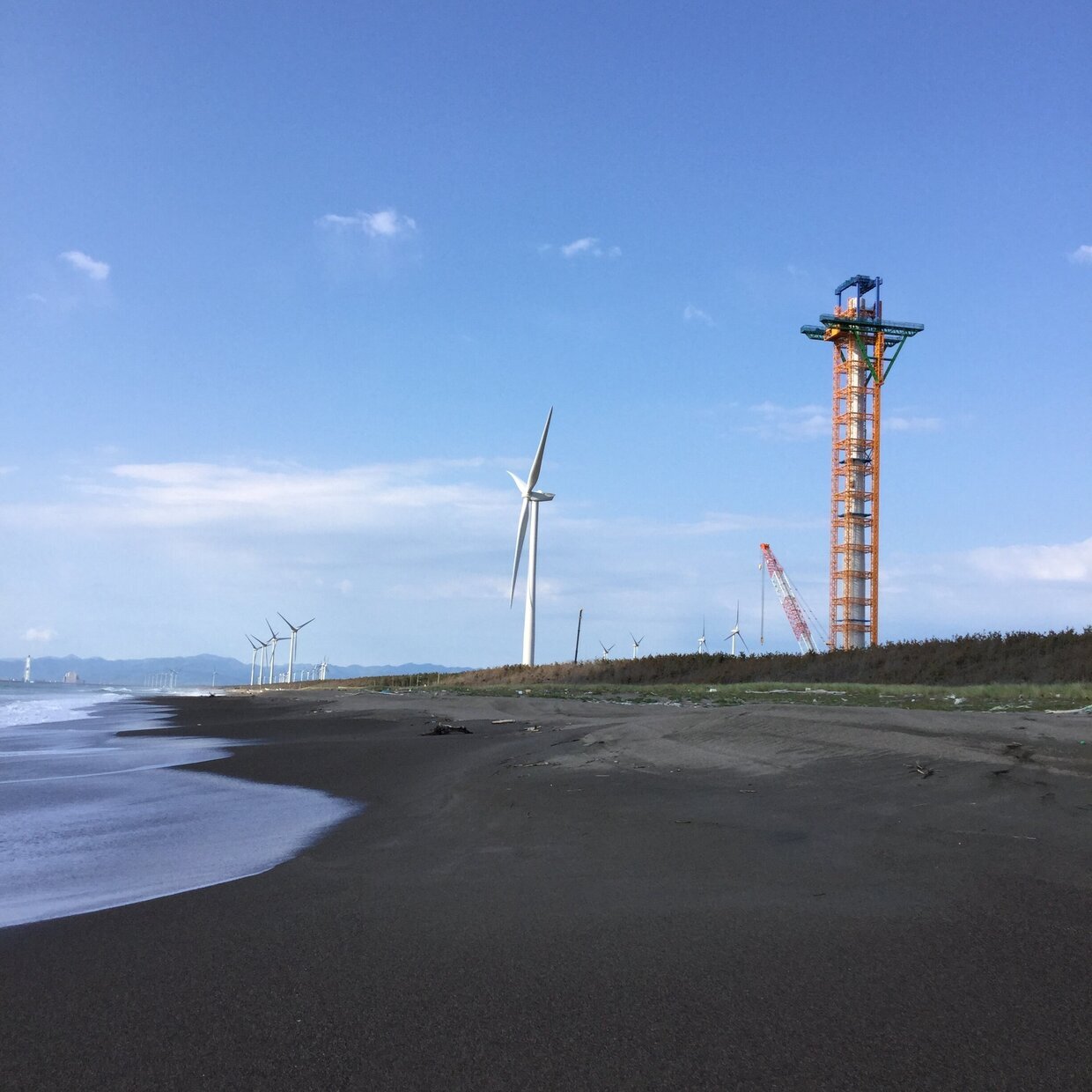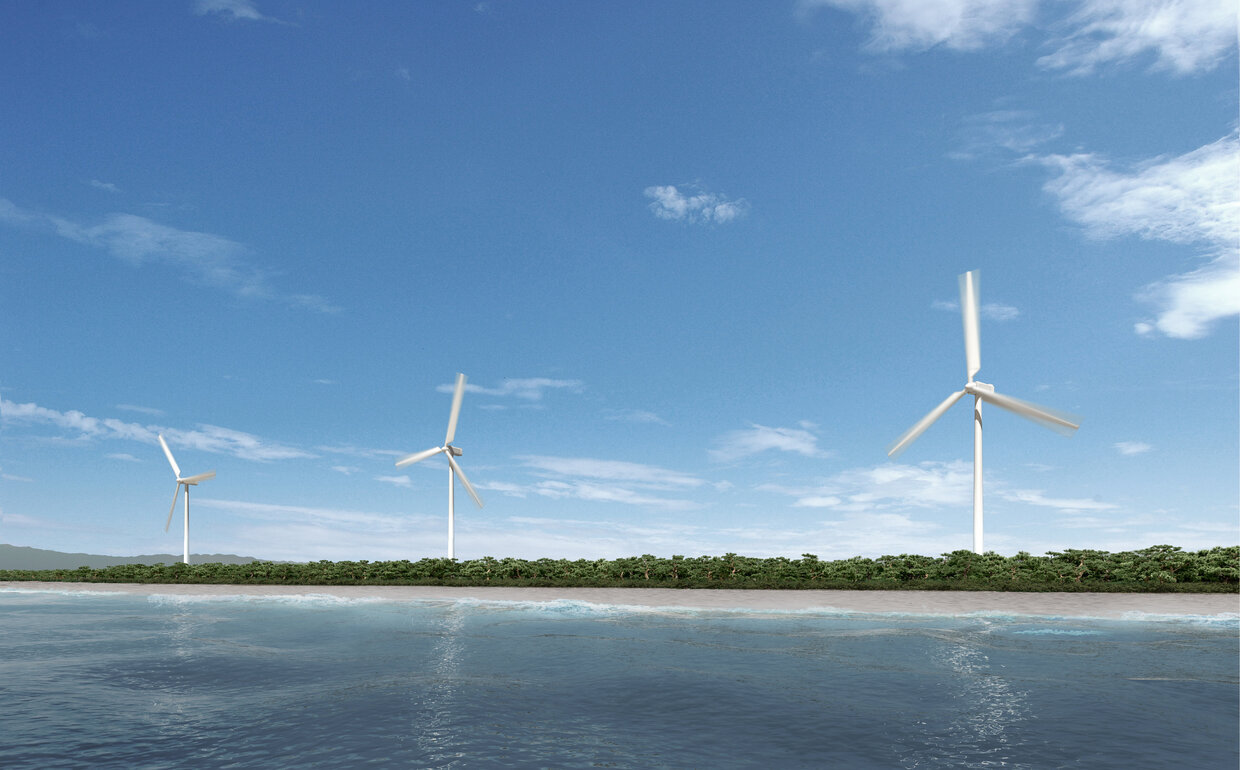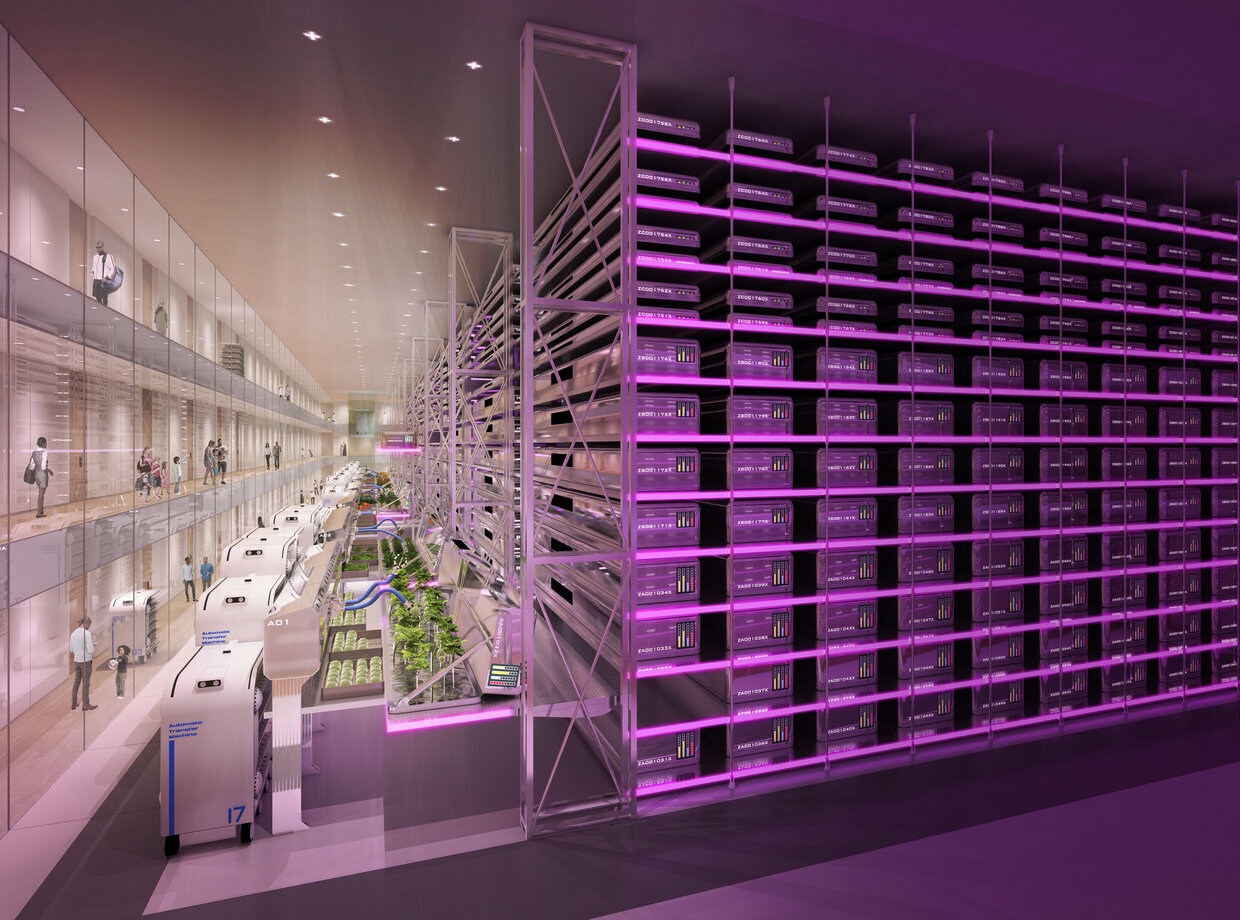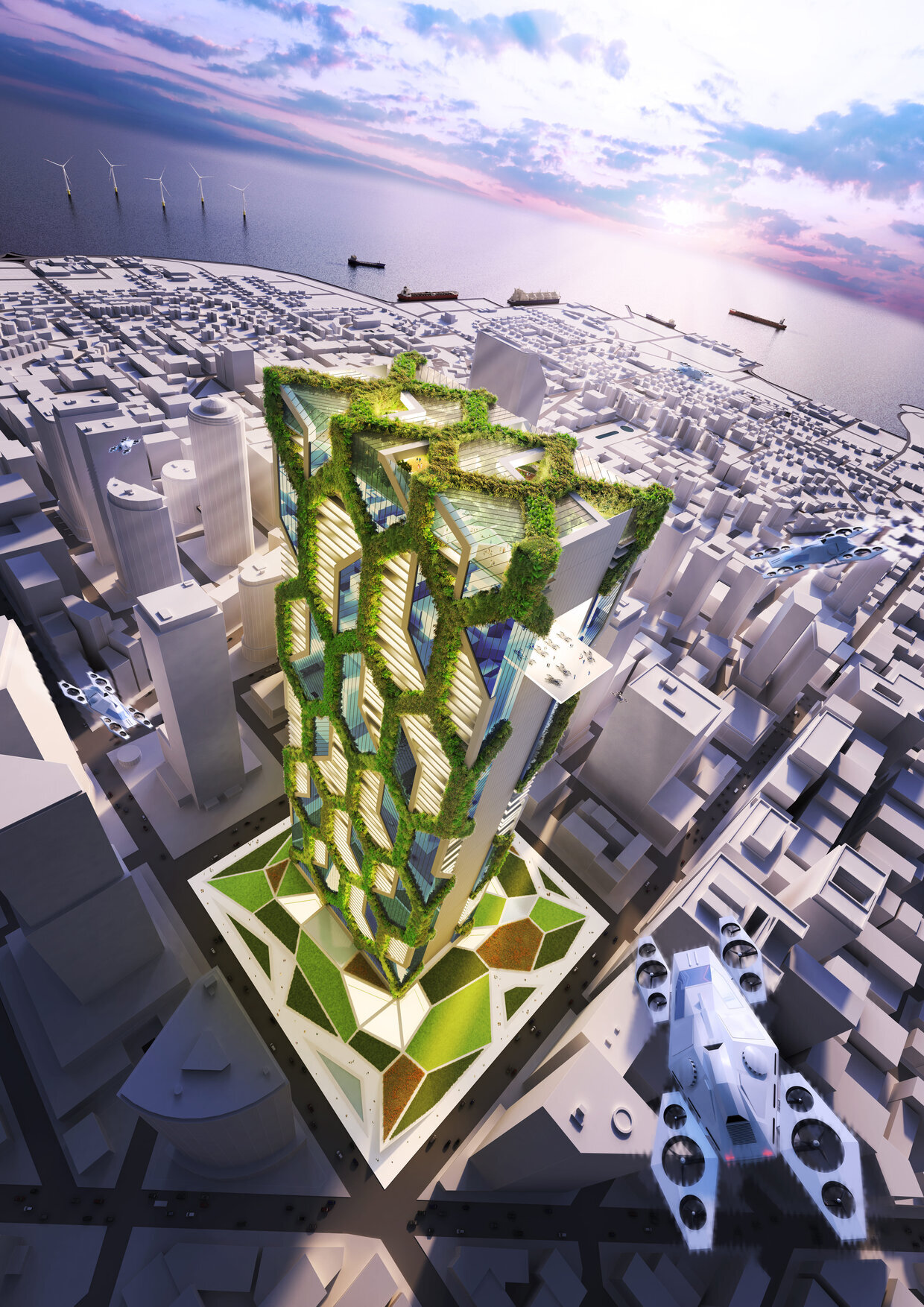Expanding Business Fields (4) New Businesses
Technology Business Development Division Initiatives
To accelerate new businesses, Obayashi Corporation newly created the Technology Business Development Division in October 2014 through the integration and reorganization of the Technology Division’s Business Innovation Department and the PFI Division. In the renewable energy field, which had been passed over from the Business Innovation Department, solar power generation facilities producing 120 megawatts of power went into operation. Five of the locations were set up in FY2016.3 (12.2 MW, total 83.2 MW), and two locations were set up in FY2017.3 (3.3 MW, total 86.5 MW). Facilities were also completed in Kushiro Town Toritoushigenya in April 2017, and Hyuga City Hichiya in May of the same year. In addition, as described below, the company has been working on natural energy power generation, including wind power, woody biomass, and geothermal power, as well as the full-scale development of its agricultural business. The company also used its technologies from hydrogen-related businesses and other areas to advance into new fields. Furthermore, the company strengthened its efforts in PPP projects by making use of its expertise in areas such as business scheme formation and fund procurement. The company had cultivated this know-how through its PFI business, which had boasted a class-leading track record in Japan.
In this way, the Technology Business Development Division played a central role in the promotion of new businesses such as the renewable energy business and agriculture, and developed New Businesses into the fourth revenue pillar after Building Construction, Civil Engineering, and Real Estate Development in an effort to diversify and stabilize the earnings base.
Strengthening the PPP Business
In the PPP Business sector, the company increasingly focused on gathering information from the upstream stage, and tackled each project based on business proposals that fit the needs of clients. Obayashi Corporation and the group companies strengthened PPP Business initiatives in facility maintenance management and operation in an effort to increase revenue across the entire group.
The main project undertaken during this period was the Kanagawa Prefectural Police Drivers’ License Examination Center Improvement Project that was contracted in March 2015. The aim of the project was to set up a new drivers’ license examination center on the grounds of the former Cancer Center, after transferring and improving the new Cancer Center to the grounds of the current facility’s practical test course (Kanagawa Cancer Center Adopting BTO Scheme led by Obayashi Corporation). It would see the Yokohama Branch, Architectural Design & Engineering Division, and Technology Business Development Division PPP Project Department come together and demonstrate their collective strengths. In addition to a facility development plan that shortened the construction period by 12 months and a layout plan that took into consideration traffic congestion on the surrounding roads, the project also included a proposal for a day-care facility as an ancillary project that was highly evaluated.
Additionally, in March 2015, the company made a successful bid for the Kobe City Municipal Sakuranomiya Housing Reconstruction Project (First Period). The part of the complex housing the Sakuranomiya Housing was demolished, and 450 newly reconstructed residences and ancillary facilities were installed. In addition to the work related to the temporary and permanent relocation of residents, the company also purchased surplus land and constructed private housing. The company made a successful bid for the Fukuoka Art Museum Renovation Project in October of the same year. Large-scale renovations were carried out in line with the design concept of Kunio Maekawa, the architect who originally designed the art museum. Following the renovation, the company took charge of operation, maintenance, and management, and has, among other activities, been using the strengths of local media and hotel companies for branding and promotion to attract customers.
The following year, in March 2016, the company won a bid for the Project to Utilize the Site of the Nara Prefectural Pool: Development of a Lively Hub of Exchange Centered around a Hotel. On the site of the former prefectural swimming pool and former Nara police station, participants from both the public and private sectors worked together to develop an integrated facility for tourism, conventions, parking lots, bus terminals, food and beverage/retail outlets, and other lively facilities that would attract visitors. The company has taken charge of maintenance, management, and operation as a core project for the promotion of tourism in Nara Prefecture. In July of the same year, the company was successful in a bid for the Higashiosaka City New Civic Hall Construction and Operation Project. The project sought to develop and commence operations of a new civic center that would fulfil the role of a multi-purpose hall and be used as a hub for the promotion of culture and arts on the site of the former Municipal Central Hospital (city-owned), following the closure of the cultural civic halls.
Constructing the First Wind Power Station
Starting with the Solar Power Generation Business, which was launched in 2012, the company has been promoting its power generation business using renewable energy such as wind and biomass.
Of the projects undertaken as part of the Wind Power Generation Business, construction began in July 2016 in the town of Mitane, Akita Prefecture, for the company’s first onshore wind power generation business: Mitanehamada Wind Power Station. The power generation facility has three wind turbines, which are approximately 92 meters in diameter and have a total power generation capability of 5.97 megawatts, equivalent to the annual electric power consumption of 5,000 households, or 70 percent of the town of Mitane. Construction of the approximately 125-meter wind turbines was carried out with consideration given to safety and environmental preservation of surrounding areas by way of the Lifting Method (Wind Lift), which allowed engineers to assemble the turbines in as small an area as possible without using large cranes.
The Mitanehamada Wind Power Station was completed in July 2017, with operations commencing in November of the same year. The power station is managed by the Obayashi Wind Power Mitane Corporation.


Start of Construction on the First Ever Biomass Power Generation Facility
In March 2016, the Obayashi Group’s first ever biomass power generation project, Otsuki biomass power plant, began in the city of Otsuki, Yamanashi Prefecture.
The Otsuki biomass power plant, located on a vast 20,000-square-meter site, is operated by Otsuki Biomass Power, which was established by the renewable energy business company Obayashi Clean Energy Corporation. The plant has a power generation capability of 14.5 megawatts, which is equivalent to the annual electric power consumption of approximately 30,000 households. This is one of the biggest woody biomass power generation businesses in Japan to use domestically sourced materials. For fuel, it uses about 150,000 tons per year of wood chips made from unused thinned wood, mainly sourced from pruned branches from Yamanashi Prefecture and other areas across the Kanto region. Commercial operations at the plant commenced in December 2018. This marked the first time that a company in the construction industry used the renewable energy Feed-in-Tariff (FIT) system as a way of entering the woody biomass power generation sector.
New Initiatives in the Agricultural Field
March 2016 saw the first shipment of cherry tomatoes grown at the solar-powered plant factory operated by Oak Katori Farm in the city of Katori, Chiba Prefecture, setting in motion the farm’s full-fledged entry into the agriculture business.
Oak Katori Farm is an agricultural production business that grows cherry tomatoes, and was set up as an Obayashi Group company in November 2014. The company had been considering entering the agricultural business as an aspect of the company’s fourth pillar—New Businesses—for some time, however, the cherry tomato cultivation business at Oak Katori Farm was the company’s first foray into the field.
Oak Katori Farm partnered with Wagoen, an agricultural producers’ cooperative corporation with expertise in the agricultural business, receiving guidance on cultivating crops while at the same time making use of its sales channels to promote the business. At first, cherry tomatoes were grown in solar-powered plant factories, each approximately 2,000 square meters in area. The next year, however, facilities were expanded to approximately one hectare. Along with the expansion of the plant factories, the company started using ICT to collect and analyze environmental data taken both inside and outside of the factory, using the data to predict and manage production speed and harvesting time. In addition, location information management systems were used to visualize the movement of people and examine how to optimize tasks, allowing the company to accumulate technology and expertise related to environmental control and labor savings cultivated in the construction business.
The COMPACT AGRICULTURE Concept—Agriculture in the Era of Society 5.0
With a rapidly aging society and population decline, how will Japan be able to secure agricultural workers and maintain production? One answer is to advance smart technology using ICT, AI, and robotics in the same way as in the construction industry, with an aim toward a new society: Society 5.0.
Society 5.0 refers to a new society that follows on from Society 1.0 (hunter gatherer society), Society 2.0 (agricultural society), Society 3.0 (industrial society), and Society 4.0 (information society). The Japanese government advocated in its 5th Science and Technology Basic Plan that Society 5.0 is the shape of the future society we should be aiming toward. Optimized agriculture to produce food locally for local consumption will involve people wearing robotic suits and using systems to gather big data. It will be run by renewable energy and produce what local residents need and the amounts that they need, with no food wasted. This is the Obayashi Corporation project team’s COMPACT AGRICULTURE vision for a compact and fully sustainable society. It could be called one of the aims of Society 5.0.

Production facilities are equipped with two robotic arms per module. All agricultural tasks are carried out by robotic arms. Production facilities can be seen up close from the living space. The communication space is fitted with plant beds where people can see and experience harvesting, a home vegetable garden experience area, and screens that show how food is produced in factories.
Produce is delivered to each home using an automated logistics system that sends food when it is needed and only in the necessary amount, thereby curbing food waste.

Making it possible to produce food in small areas enabled the construction of production facilities in built-up urban areas.
Production facilities are concentrated at the inner part of the building, while residences are arranged against the outer walls where natural light streams in.